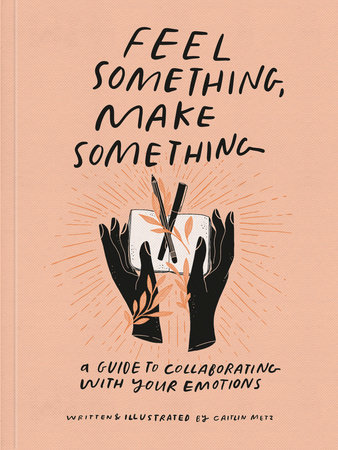Excerpt
Feel Something, Make Something
IntroIn which I tell you a bit about what making things means to meI spend my days documenting the sky, my body, and the thoughts filling my head. Half-finished poems litter my notes app in strange configurations that often don’t make sense . . . until suddenly they do. I don’t question how the wisp of a cloud sends me running to the rooftop balcony, or why I must draw the way fear eats away at my belly. Sometimes it takes months or years for patterns to emerge between all my practices. A trail of clues; secrets not yet revealed. An intimate collaboration between me and the universe.
I hope these pages spark your very own practice of listening and responding to the surges of desire and oceans of emotion within you.
Here we embark on the magnificent sequence, old as time herself: Feel something, make something. Rinse and repeat.
This book is about release: releasing your tangled thoughts and tenderest emotions through the act of art–making. It’s about letting it all out onto paper so you can make sense of your feelings from some distance. It’s the alchemy of transmuting emotion into artifacts. This work allows you to hold the inexplicable in your hands, run your fingers across the spine of longing, crumple grief in your fist, or pin your rage to the wall so you can step back, take a breath, and examine the contents of your heart and mind from a fresh point of view.
When I create from my feelings, the enigmatic becomes manifest; mark-making reverberates like an echo delineating the edges of my consciousness, a mirror reflecting the inconceivable. Something transcendent happens when we allow the swirling, fearsome tangle to tumble out onto paper, canvas, or clay or into poetry, song, or dance.
This process—this aching, messy, broken, perfect process of scribbling thought and feeling onto paper—is the work. It’s everyday magic. And it’s available to us at a moment’s notice.
So where do we begin? The hardest part for me is pausing to listen. In a lot of ways, knowing when to make something is a chicken-and-egg situation. I know it’s time to create when I feel overwhelmed, tired, irritable, anxious, etc. But I’m so good at pushing past my feelings that I often don’t realize I’m having them until I pause . . . and for me the pause comes when I make something. So as you can see, sometimes you have to start before you know where to begin.
I sharpen my sensitivity to the quiet whispers of my body and mind every time I create work in collaboration with the feelings and sensations resonating inside.
There’s a beautiful quote attributed to Viktor E. Frankl about the power of listening/noticing: “Between stimulus and response there is a space. In that space is our power to choose our response. In our response lies our growth and our freedom.”
The simple act of picking up a pencil stretches that liminal space of feeling into a place of rest where I can explore all manner of possible responses.
Over the years, I’ve found myself repeating the same patterns when processing my emotions. The practices I’m sharing here are the ones I’ve turned to intuitively over the past two decades— my sanctuary when leaving religion, the voice I borrowed to whisper my way out of the closet, a healing balm to soothe C-PTSD.
As long as I can remember, drawing has been my refuge. I leave the ache of this world, everything goes still, and the only thing that matters is the line on a page. I would draw for hours and hours as a child. Copy paper on top of a book balanced on my knees, Mead mechanical pencil in my left hand, eraser crumbles littering the couch cushions around me.
My favorite thing to draw was women: with endless piles of hair and unimaginably tiny waists, wearing Victorian-era dresses with lots of flounces. Secretly I’d draw them naked first, huddled in a corner so no one could see, quickly drawing a dress over the curves that made me feel warm in ways I didn’t yet understand.
Drawing—or mark-making—has been a space for me to explore concepts without committing—before language, there were images. (I like to say “mark-making” over “drawing” because it softens the idea of drawing as a rigid, specific type of skill. Anyone can make a mark!) Mark-making allows my body to speak about things for which there are no words. Illustrating my anxiety gave me language to ask for help. Repetitive lines introduced me to meditation. Notes scrawled on bar napkins became lifeaffirming manifestos.




